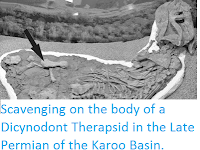Odontoma is a condition known in a variety of Mammal species in which small tumours appear in the jaw, made up of differentiated tooth material with differentiated enamel and dentine. This can lead to the re-absorption of the roots of the functional teeth, resulting in tooth loss. This condition has been detected in the recent fossil record, in species such as Mammoths up to a few million years old, and can be expected to have existed in the common ancestor of all the animals in which it has been recorded (Humans, Horses, Mammoths and Deer), probably in the Late Cretaceous, its presence earlier in the fossil record is unknown.
In a paper published in the journal JAMA Oncology on 8 December 2016, Megan Whitney, Larry Mose and Christian Sidor of the Department of Biology at the University of Washington, describe a case of odontoma in a 255-million-year-old Gorgonopsian Synapsid from the collection of the National Museum of Tanzania.
Synapsids split from the ancestors of modern Reptiles and Birds about 320 million years ago. Today the only surviving Synapsid group are the Mammals, but in the Permian a diverse range of Synapsids dominated most terrestrial ecosystems. The Gorgonopsians diverged from the ancestors of Mammals before the development of traits such as large brain size, diphyodonty, distinct thoracic and lumbar vertebrae, and 3 middle ear ossicles, though they did have Mammalian traits such as differentiated teeth and an upright gait.
Whitney et al. worked upon a right dentary (jawbone) of an unnamed Gorgonopsian. The specimen was embedded in polyester resin, then cut it into a series of thin sections, which were ground down to a thickness of approximately 100 μm using a variable-speed grinder and polisher. This revealed a series of eight ectopic toothlike lessons, close to the labial edge of the functional canine root. These range in size from 0.3 to 3.9 mm, some of which incur into the root of the tooth, causing loss of the cementum and dentine.
(A) Computed tomogram of a Gorgonopsian anterior dentary (red) with dentition (blue) highlighted (National Museum of Tanzania specimen RB382), indicating approximate positions of thin sections where the pathologic features are visible (National Museum of Tanzania specimen RB404). Successive slides representing the cervical (B) and midroot (C) portions of the functional root with odontomes. (D) Clustering of odontomes at the apical end of the tooth root. All histologic images were taken under cross-polarized light. Ca indicates root of canine; d, dentine; e, enamel; i, root of incisor; od, odontome; and pc, root of postcanine. Whitney et al. (2016).
See also...
Follow Sciency Thoughts on Facebook.






